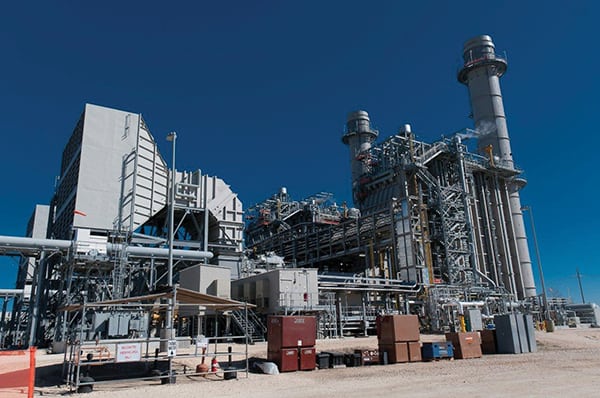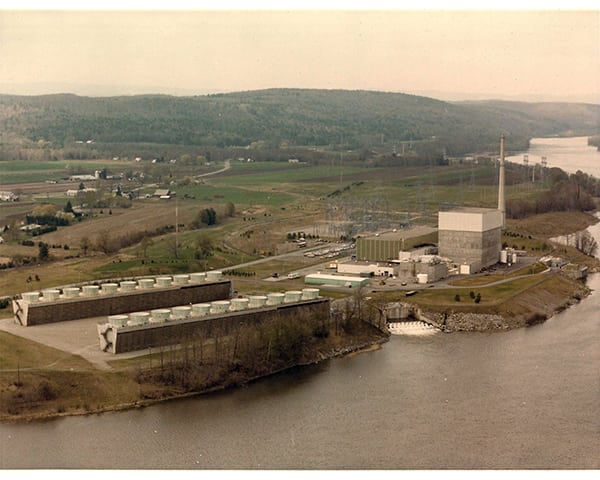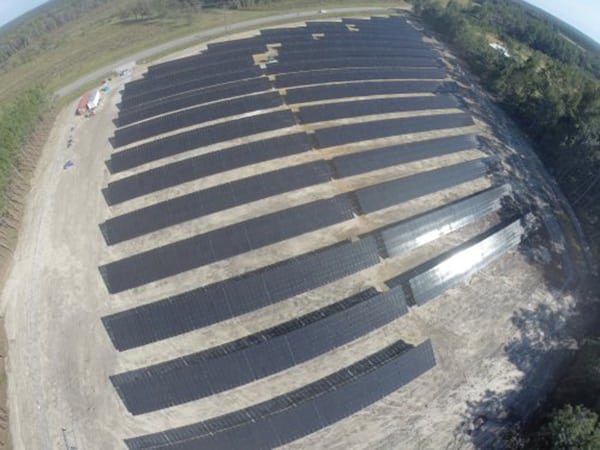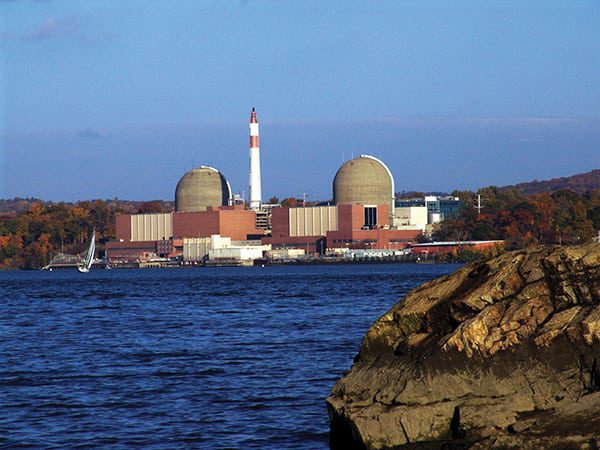Entergy Sheds Uneconomic Merchant Nuclear Plants to Focus on Regulated Business
Around the turn of the century, Entergy took a flyer on older, low-cost nuclear units to bid into new competitive wholesale markets. Facing pressure from cheap gas and unanticipated political challenges, the company now grapples with disentangling itself from unsustainable investments in merchant nuclear generation.
Entergy Corp., a dominant investor-owned utility in the middle south, hugging the Mississippi River drainage area from New Orleans to Memphis (including a piece of Texas), faces what may be a unique generation transition. New Orleans–based Entergy’s future may depend on how it can shed heavy, money-losing investments made at the turn of the 21st century in merchant nuclear units far from its regulated Dixie service territory.
Entergy’s Generating Profile Emphasizes Gas and Nuclear
Entergy has about 30,000 MW of generating capacity, including 5,000 MW of merchant generation outside of its state-regulated Mississippi River service territory. The majority of the Entergy companies’ capacity is gas, about 17,500 MW, with plants dating back to the 1950s. The largest gas-fired station is Ninemile Point in Westwago, La., at 2,083 MW. The first unit at the four-unit plant went into service in 1955. The most recent, Ninemile Point 6, a 560-MW combined cycle unit, entered service in 2014 (Figure 1).
 |
|
1. Ninemile Point 6. With easy access to abundant natural gas, it’s no surprise that Entergy’s portfolio in the Gulf Coast states favors that fuel. Courtesy: Entergy |
Entergy’s other large gas-fired plants are the 1,825-MW Sabine in Orange, Texas, and 1,651-MW Willow Glenn in St. Gabriel, La. Given the utility system’s location in the heart of the Gulf Coast oil patch, that generating profile is no surprise. But elsewhere, the company has sold off a merchant gas plant (see sidebar, “Entergy Sells Large R.I. Gas Generator”)—just one sign of its lost appetite for the merchant business.
|
Entergy Sells Large R.I. Gas Generator As Entergy’s wholesale business moved to close nuclear units in the Northeast, the company was also unloading a large, modern combined cycle gas plant in Rhode Island. Sale of the 583-MW Rhode Island State Energy Center (RISEC) to The Carlyle Group’s Cogentrix Energy Power Management closed last December. Entergy bought the plant from NextEra Energy Resources for $346 million in December 2011. Entergy upgraded the capacity of the 13-year-old plant from 550 MW to 583 MW, then agreed to sell it to Carlyle’s Cogentrix last fall for $490 million. In a written statement, Entergy CEO Leo Denault said, “RISEC has been a good investment for us, and its sale is consistent with our strategy for Entergy Wholesale Commodities—to be disciplined about reducing risk and freeing up financial resources for other opportunities.” RISEC sells power into the ISO-New England wholesale market. Matt O’Connor, Carlyle managing director, said, “RISEC is among the most efficient combined-cycle facilities in New England and is well-positioned to capitalize on strong regional market dynamics for reliable generation. Additionally, the retirement of aging generation in the region is putting greater emphasis on efficient gas-fired generators, like RISEC, to meet everyday electricity demand.” |
The oldest generators on the Entergy system are hydro units dating back to the company’s earliest days (for a brief corporate history, see the sidebar, “From Sawdust to Utility Giant”): three 4-MW plants in Malvern, Ark., installed in 1925, and two 31-MW units in Hot Springs, Ark., circa 1932. Those are the only renewable assets on the utility books, according to the Entergy website. The wholesale side includes 40 MW of wind in Iowa and another 40 MW in Texas.
|
From Sawdust to Utility Giant Entergy describes its origins as “a pile of sawdust and a handshake.” H.H. Foster, head of a lumber and land company in Arkansas, hooked up with energy entrepreneur Harvey Couch of the Arkansas Power Co. in 1913. With a franchise to provide electricity to two Arkansas towns, Couch agreed to a handshake deal to buy sawdust from Foster’s lumber mill as boiler fuel to generate power. The electric company was called Arkansas Light and Power. Within a decade, according to Entergy’s official history, Couch built a 9-MW hydro generator on the Ouachita River, along with a 300-mile distribution system. Couch had a larger vision. He bought up independent electric companies in Mississippi, launching the Mississippi Power and Light Co., planning to link Arkansas and Mississippi. Couch formed the Louisiana Power Co. to take advantage of that state’s abundant natural gas, starting up the Sterlington gas-fired station in 1925. At 30 MW, it was the largest power station south of St. Louis, Mo. Enter Sidney Mitchel, a leader of the Electric Bond and Share Co. (Ebasco), a General Electric company. In the early 1920s, Mitchel gobbled up the electric service business in New Orleans and was moving into Little Rock and Memphis. Couch and Mitchel soon joined forces, creating Electric Power and Light Corp., run by Couch. This company would eventually become Entergy. Despite the 1930s’ Great Depression, the company survived as part of the empire built by Samuel Insull, Thomas Edison’s former secretary and a business genius. Insull created a pyramid of electric holding companies, such as Ebasco, owning holding companies owning holding companies owning electric companies. The 1935 Public Utility Holding Company Act forced the breakup of Insull’s business pyramid, including Ebasco. In 1949, Ebasco’s Electric Power and Light Corp. became stand-alone Middle South Utilities, consisting of Arkansas Power and Light, Mississippi Power and Light (MP&L), Louisiana Power and Light (LP&L), and New Orleans Public Service. Over the next 40 years, the utility holding company grew and began to diversify away from its reliance on natural gas. Arkansas Power and Light in 1968 won an Atomic Energy Commission construction permit for the first unit of Arkansas Nuclear One (ANO), an 846-MW Babcock & Wilcox pressurized water reactor (PWR), which went into service in 1974. ANO Unit 2, a 930-MW Combustion Engineering PWR, went commercial in 1978. In 1970, LP&L announced plans for the Waterford nuclear plant near Taft, La. Two years later MP&L announced it would build the 1,266-MW Grand Gulf station near Port Gibson, Miss., eventually cancelling plans for a second unit at the site. Middle South’s first coal-fired plant, the two-unit, 1,700-MW White Bluff station, came online near Pine Bluff, Ark., in 1980 and 1981. (Entergy announced last year that it will phase out White Bluff by 2028.) Middle South became Entergy in 1989 as a rebranding effort, the first of the wave of sometimes comical renamings of electric and gas companies in the 1990s and 2000s—including Cinergy, Exelon, Dynegy, Ameren, NRG, Dominion, and FirstEnergy. In 1992, Entergy acquired Gulf States Utilities, operating in eastern Texas and southwest Louisiana. |
Coal is a relatively small part of the Entergy generating base, totaling 2,244 MW, all added to the Entergy system between 1980 and 1984. The largest coal plant is the two-unit, 934-MW White Bluff plant in Redfield, Ark., which went into service in 1980 and 1981.
After gas, nuclear is the second-largest generating technology for the utility system: five units with a total of 5,222 MW in nameplate capacity. Entergy commissioned Arkansas Nuclear One’s (ANO’s) 836-MW Unit 1 in 1974 and the 987-MW Unit 2 in 1980. Grand Gulf at 1,266 MW, arrived in Mississippi in 1985, along with Waterford 3 (1,159 MW) in Louisiana. River Bend in Louisiana (974 MW) went into service in 1986.
Risky Merchant Power Business
Perhaps emboldened by its experience with nuclear generation within its regulated business, Entergy, along with some other utilities with successful regulated nuclear generation, made a high-stakes bet as restructuring swept the electric utility business in the late 1990s. At the time, many experts believed that nuclear generating plants, with their high embedded capital costs and substantial operation and maintenance expenses, would not be able to compete in competitive markets.
Entergy disagreed, figuring it could acquire older units in wholesale markets at fire-sale prices. Some utilities with only one unit under their control, and comfortable with cost-of-service economic regulation, were terrified of the impacts of competitive markets. They were eager sellers. Entergy saw those plants as potentially solid competitors in wholesale markets.
So Entergy launched a business strategy of buying up elderly nuclear units in wholesale territory. Over time, the company acquired the Vermont Yankee Nuclear Power Plant (operating license [OL] issued in 1972), Pilgrim in Massachusetts (OL 1972), the two Indian Point units in New York (OLs 1973 and 1975), and Palisades (OL 1971) in Michigan. At peak, Entergy was operating six merchant nuclear units, about 5,000 MW of capacity, along with five nuclear units in its regulated companies, also representing about 5,000 MW. The company was looking at a list of 10 to 12 other plants that might be acquisition targets for merchant operations, according to a former company insider.
Entergy’s merchant nuclear strategy soon encountered problems—technical and political. Vermont Yankee (Figure 2) suffered a partial collapse of its wooden cooling towers in 2007. It was not a nuclear accident, but it sowed doubt among already skeptical state regulators and political actors, including then-Governor Jim Douglas, who had long argued in favor of closing the plant. It also cost Entergy millions of dollars in reduced output from the plant and repair bills.
 |
|
2. Down for the count. Technical, political, and, finally, economic woes led to permanent shutdown of the Vermont Yankee Nuclear Power Plant in December 2014. Courtesy: Nuclear Regulatory Commission |
In 2010, a tritium leak at Vermont Yankee contributed to political push-back against the aging nuclear unit, again costing the company millions and damaging its credibility, as it was unable to locate the leak source. The Vermont Yankee tritium leak also cost several high-level company executives their jobs.
Entergy also faced intensifying political opposition in Massachusetts and New York, where both the Pilgrim and Indian Point plants have long been controversial. According to a former Entergy executive, who spoke to POWER on condition of anonymity, the company never conducted any political risk analysis of its merchant nuclear purchases, focusing solely on economics. Both economics and politics came to bedevil Entergy’s merchant operations. The company would have been better off economically had it understood the local politics, the former executive said.
Economics upset Entergy’s profit-and-loss calculations just as politics complicated its merchant nuclear business model. The development of hydraulic fracturing and low-cost, plentiful natural gas hit the competitive wholesale generating market beginning around 2008. That left Entergy with nuclear plants unable to sell their output at a profit.
In discussing the company’s third-quarter results last November, Entergy CEO Leo Denault commented, “Wholesale electricity markets are failing to produce accurate price signals to reflect the true marginal cost of providing energy and capacity, challenging the long-term sustainability of these markets.” The nuclear industry has been arguing, unsuccessfully so far, that wholesale markets don’t account for the value of the zero carbon dioxide emissions of nuclear generation.
Nuclear Shutdowns and Threatened Shutdowns
In 2013, Entergy announced it would close the 620-MW Vermont Yankee, which it acquired in 2001 for $180 million. Despite long-running, intense political battles over the plant in Vermont, economics ended its 41-year run. Bill Mohl, head of the Entergy Wholesale Commodities business unit, told the Wall Street Journal, “The bottom line is the plant’s costs exceed its revenue as we look into the future. The decision was solely based on economics.”
Last fall, Entergy announced it will close the 690-MW Pilgrim plant on Cape Cod, which it acquired in 1998 for $80 million (the plant cost $231 million to build in 1972), and the 839-MW FitzPatrick plant in upstate New York. That leaves Entergy’s wholesale nuclear program potentially with three operating units: the two Indian Point units, totaling 2,200 MW, and the 800-MW Palisades plant in Michigan. The fate of those units is also in doubt.
In New York, Entergy finds itself in a complex, convoluted political battle with Democratic Gov. Andrew Cuomo and a bevy of anti-nuclear and green energy activists. Entergy wants to continue operating Indian Point (Figure 3); Cuomo et al. want to close it. Entergy says it will shut down FitzPatrick; Cuomo wants to keep it running. For Entergy, as Bill Mohl said about Vermont Yankee, it’s all about economics. For Cuomo, it’s entirely politics.
Cuomo, son of the legendary Democratic politician Mario Cuomo, also a New York governor, has finely honed political instincts and sharp elbows. Democratic politicians and environmentalists in the Empire State have long battled to close Indian Point because of its 45-mile proximity to the nation’s largest city. Indian Point opponents are Cuomo’s base; he openly campaigned to close Indian Point when he was New York’s attorney general from 2007 to 2010. New York, under Cuomo’s direction, argues that Entergy should build closed-cycle cooling towers at Indian Point, at a cost of around $2 billion, a likely show-stopper.
In the case of FitzPatrick, the nuclear plant sits in political territory largely hostile to Cuomo. He would draw blame if the plant shuts down and some 600 workers lose good jobs—along with spin-off damage to the local, already shaky economy. Cuomo is also trying to keep Exelon’s two upstate merchant nukes—Ginna and Nine Mile Point—in service despite the fact that they are also running up red ink.
Cuomo came up with a plan to subsidize FitzPatrick with “zero emission credits,” the equivalent of tradable renewable energy credits. They would also apply to Exelon’s 610-MW Ginna station near Rochester and Exelon’s two-unit, 1,700-MW Nine Mile Point station, FitzPatrick’s next door neighbor.
Entergy says Cuomo’s plan comes too late. FitzPatrick will shut down at the next refueling date, late this year or early in 2017. Entergy’s Mohl commented that either closing the plant or refueling take considerable lead time, rendering the Cuomo plan impractical. “It’s frankly too late for FitzPatrick,” he told Syracuse.com.
Financial Implications
UBS utilities analyst Julien Dumoulin-Smith in early February commented that, “at the moment it looks as though FitzPatrick will be closed. While relationships are frosty, a potential compromise could be worked out involving an orderly shutdown deal on Indian Point (potentially a 10-year deal, etc.), while allowing the continued operation of Fitz for the time being. This could require the governor to modify some of his public positions. But should this happen, we note that [Entergy] seems to see the business as ‘peripheral’ given the substantial closures that have transpired already.”
At Palisades in Michigan, CMS Energy, which sold the plant to Entergy, agreed as part of the deal to a long-term contract to buy power from the plant. Dumoulin-Smith commented in November that he has “doubts around the Palisades unit in Michigan and contract back to CMS (here the contract would appear to be potentially break-even or under water…).”
Entergy’s excursion into merchant nuclear generation has tarnished the company’s value. Entergy common stock was trading at over $125/share at the beginning of 2008 and plummeted to around $60/share in the summer of 2011. The company lost half of its market capitalization in three years. The stock was trading at about $70/share early this year.
Nor has the company’s regulated side been a stellar performer. Dumoulin-Smith of UBS criticized “execution at the regulated utilities, where sales have lagged prior commitments due in part to the slowdown in the regional energy and industrial economy.” He rates Entergy’s stock as a “sell.”
More Nuclear Challenges Ahead
What’s in Entergy’s future? In addition to the everyday challenges of running a mammoth holding company with 2.8 million customers, 30,000 MW of generating capacity, and $12 billion in annual revenues, the company faces the task of simultaneously decommissioning up to three nuclear plants: Vermont Yankee, where the project is already under way, and potentially Pilgrim and FitzPatrick. Nuclear decommissioning of large plants remains a frontier venture. Closing each plant will cost hundreds of millions of dollars, presumably paid out of the decommissioning funds accumulated during the plants’ operation.
Over the objections of state government officials, the Nuclear Regulatory Commission (NRC) recently approved Entergy’s Vermont Yankee decommissioning plan. Entergy expects to mothball (SAFSTOR, in NRC-speak) the plant for the next 40 to 50 years before dismantling the unit. Entergy expects that the current $655 million fund it holds to decommission the plant will grow as the innards become less radioactive, reducing the cost of dismantlement.
Conflicts between the state and the utility over decommissioning have surfaced. Vermont has sued over Entergy’s use of decommissioning funds to pay current expenses, including property taxes, and the utility’s plan to reduce emergency planning functions at Vermont Yankee.
Entergy also faces problems with the management of its operating nuclear plants. The NRC in late January sent a special team of 25 inspectors to Entergy’s two-unit ANO to address degraded safety. Following inspections in June 2014 and January 2015, the agency put the two units into what it calls “Category 4,” the highest risk level of the agency’s reactor performance ratings, just short of ordering a shutdown. A 2013 crane collapse at ANO killed a contract worker and injured eight others, triggering the NRC review.
Pilgrim also faces increased federal scrutiny, including a Category 4 designation. A series of long-standing safety issues, none of which were show-stoppers, built up in aggregate, warranting increased oversight, according to the NRC.
Most recently, in early February, Entergy discovered elevated tritium levels in three of 40 monitoring wells at Indian Point. In a statement, the company said, “While the effect of these elevated values is less than one-tenth of one percent of federal reporting guidelines, Entergy made voluntary notification to the NRC, state agencies and key stakeholders.” Gov. Cuomo offered a different spin, citing “alarming levels” of the slightly radioactive isotope. “This latest failure at Indian Point is unacceptable,” he said. He ordered the state’s Department of Environmental Conservation and the Health Department to “fully investigate.”
At the end of January, Entergy announced it had hired A. Christopher Bakken III as the new chief nuclear officer, effective this month (April). Bakken is a 30-year nuclear veteran, most recently working as the Electricité de France project director at the Hinkley Point C project in Great Britain. He will be responsible for all of Entergy’s nuclear operations.
Entergy also must cope with slow growth in its main service territory, particularly as the energy and petrochemical industries that underpin its local economy confront falling oil and natural gas prices. The company’s demand growth projections have been overly optimistic recently, according to Dumoulin-Smith.
Slow Start on Renewables
Entergy is gingerly testing renewables, for which it has historically shown little interest. MP&L is installing three pilot solar photovoltaic installations in Mississippi (Figure 4), totaling 1.5 MW, which the company says are “the first-ever utility owned solar projects in Mississippi.” The cost for all three sites, according to the company, is under $5 million.
 |
|
4. Inching toward solar power. This facility in Mississippi is one of three solar photovoltaic installations in Entergy territory, totaling 1.5 MW. Courtesy: Entergy |
Meanwhile, in November last year, Entergy Louisiana stopped providing full (retail) net metering credit to customers with rooftop solar panels, as it had reached its 0.5% capacity threshold. In a letter to the Public Service Commission, Entergy Louisiana Senior Counsel Michael Plaisance said the utility’s customers had installed 8,203 net-metered solar systems with a total capacity of 47.4 MW—the equivalent of 0.57% of Entergy’s peak load of 8,270 MW in October 2014. Then, in December, the Mississippi Public Service Commission approved a net metering plan for customer-sited solar generation, with a cap of 3% of system peak load and at the wholesale rate plus 2.5¢/kWh (rather than the retail rate).
In an email, Entergy told POWER, “Only one of our five utilities operates in a state with a renewable portfolio standard (Texas). Our current retail rates are well below the national average…. So with that in mind, we have taken a number of actions in recent years related to renewable energy…. Entergy is constantly working across our five operating companies to gain the necessary information and expertise to make renewables a more viable, cost-effective option to serve our customers.”
The company notes that it has bought “millions of dollars” in Texas renewable energy credits to satisfy its renewable targets. In February, New Orleans Public Service broke ground on a 1-MW solar project combined with lithium-ion battery storage. ■
—Kennedy Maize is a long-time energy journalist and frequent contributor to POWER.
